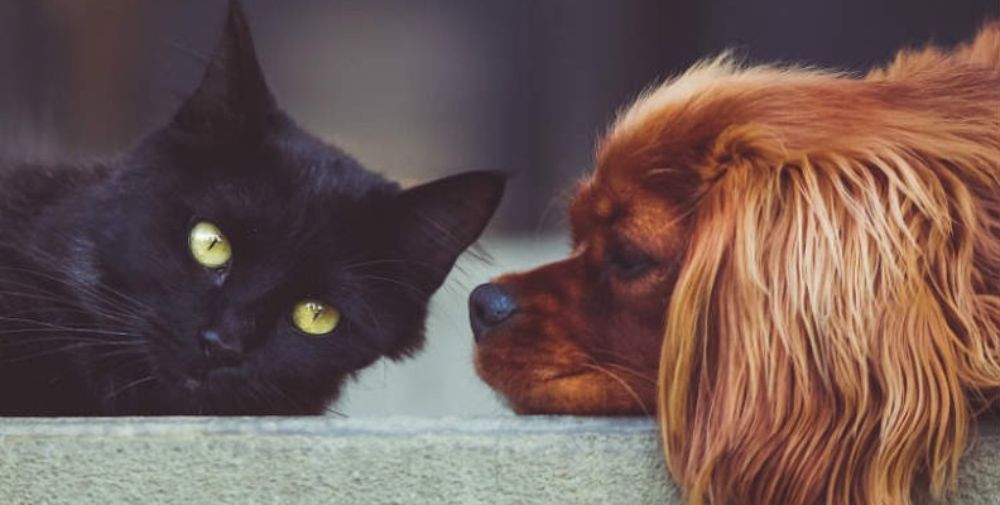
Dogs may have been man’s best friend for thousands of years, but that doesn’t mean you fully understand them (at least not yet). From the best doggy diets to their oral health, there are plenty of myths shrouding your buddy’s way of life. Uncover the secrets of how dogs see, smell, and understand us – and sort the facts from the fiction – with our myth-busting guide.
Are Dogs Colour Blind?
Have you ever wondered if dogs see in black and white? Are dogs colour blind? Or can they see in the dark?
To understand dog vision, you first need to know about the anatomy of their eye. It’s made up of the sclera, conjunctiva, cornea, iris, pupil, lens, and retina. The sclera is the white part of the eye, and the conjunctiva is the lining of the eyelids that help to clean and protect the eye, alongside the third eyelid. The cornea is a transparent layer that focuses and controls the light that enters the eye.
The iris is the coloured part of the eye with the pupil in the middle. They work together to control the amount of light that is let through to the back of the eye. Behind the pupil is the lens which focuses the light. It changes shapes to help the eye focus on objects.
At the back of the eye is the retina which contains photoreceptor cells called rods and cones that convert light into nerve signals. Rods recognise black and white so are useful in dim lighting to detect shapes and motion. Cones detect colours and work on sharpness and clarity. Although dogs don’t have vision quite as detailed as ours in day light, they do have far superior night vision compared to humans, and this is because they have far more rod cells in the retina than humans do.
Dogs do also have some colour vision, but not as much as humans, as they have less cone cells and only have two types of cone cells (blue and yellow/green). Therefore, they can see shades of blue, yellow/green, greys, black and white. The only colours they can’t see are shades of red.
How Do You Calculate Dog Years?
One dog year equals seven human years. So if your dog is 5 years old, they would be 35 in human years! A dog will age quicker than their owner, but the speed of this depends on their stage of development. For example, a dog will grow fastest in their first two years, when it transitions from pup to adult, but then slows considerably.
The average lifespan of a dog varies from breed to breed, with some breeds living well over 15 years. Smaller breeds tend to live longer than larger breeds, so a terrier will likely live longer than a Great Dane!
Are Dogs Omnivores?
Yes! Our canine companions are actually omnivorous. Whilst the bulk of their diet tends to be meat based, they also benefit from other nutrients too. It’s really important that your dog has a healthy, balanced diet and your veterinary team will be able to talk you through the options for your pet. Read more about your dog’s nutrition.
Are Dogs Smarter Than Cats?

Yes, dogs are said to be more intelligent than cats. While each four-legged friend has their own strengths and skills setting them apart, science has proved that our pooches are smarter than their feline counterparts. Dogs have twice the number of neurons (the cell responsible for transmitting information) than cats, according to a recent study.
Other studies also suggest that dogs understand their owners better than cats, with many pooches being able to comprehend over 100 words.
How Far Can a Dog Pick Up a Scent?
Dogs have a remarkable sense of smell, roughly 10,000 to 100,000 times stronger than humans’. However, their ability to identify a scent depends on various factors such as their breed and age, plus the training they’ve had. Bloodhounds have the best sense of smell overall. They’ve been known to follow a trail for more than 130 miles.
Why Do Dogs Wag Their Tails?
You can tell a lot about a dog's mood from their body language and tail. The position and movement of a dog's tail can communicate its feelings and intentions. A relaxed and comfortable dog will have a broad, smooth, sweeping tail. A helicopter tail, moving in circular motions, indicates excitement and socialness, and generally, a happy dog.
If a dog's tail is wagging slightly to the right, this shows recognition, while a tucked or low tail suggests worry. A clamped tail signals fear, while a high, fast-wagging tail indicates arousal and excitement. Dogs may also wag their tails rapidly when focusing on a scent, showing extreme concentration.
Can You Teach an Old Dog New Tricks?
Canines have a natural inclination for learning. They are inherently curious and enthusiastic about acquiring new knowledge. Dogs are constantly absorbing information from their surroundings and responding to various stimuli such as sounds, sights, and scents.
While young puppies may display more active curiosity, dogs continue to learn throughout their lives. Interestingly, adult dogs are often more trainable than their younger counterparts due to their lower activity levels. Older dogs are less prone to distractions and can maintain focus for longer durations. This ability to concentrate makes it easier for them to learn new routines.
Can Dogs Eat Fruit?
Many fruits are fine in moderation, but just like chocolate, some fruits and other household foods can be equally as bad. For example, you should never feed your dog grapes. They can cause severe illness and even kidney damage, with symptoms such as vomiting and diarrhoea. Apples can also be problematic for dogs to eat, as the core contains toxins that can make it hard for your buddy to breathe.
It’s important you know about these other foods you should never feed your dog.
Are Dogs’ Mouths Cleaner Than Humans’?
A dog’s mouth is generally a lot more unhygienic than a human’s. However, this isn’t necessarily due to how we are built, but more about environmental factors.
While humans brush their teeth regularly and take care to avoid having smelly breath, your pooch doesn't have a care in the world. From sampling the garbage to drinking out the toilet bowl, having fresh-smelling breath to greet you with probably isn’t very high on your canine companion’s agenda.
Can Dogs Smell Cancer?
The answer to this question is “possibly”! A number of studies have shown that dogs may be able to detect certain types of cancer. However, more research is required to find out what exactly they can detect and how accurate they may be. Our dogs certainly have incredible noses!
Why Do Dogs Eat Grass?
It’s thought that dogs may eat grass for a number of reasons and it’s not necessarily a bad thing that they do. Some may literally just like the taste and enjoy eating grass. For others it may be a way of adding roughage to their diet. For some it may be due to boredom and be a habit they have developed to pass the time, particularly if they’ are left for long periods on their own.
Some dogs may eat grass quickly, to make themselves sick, but although this is often given as a reason for grass eating, there is little evidence to prove that this is truly a reason why dogs eat grass. Your buddy can pick up certain intestinal worms via grass eating and so it’s important to speak to your veterinarian about appropriate deworming medication for you grass-eating pooch.
Do Dogs Sweat?
Dogs do sweat, but not in the same way that humans do - they have two types of sweat gland. Merocrine sweat glands are found in the paws, and you may notice them leaving sweaty footprints when they walk. They release small amounts of sweat when hot or nervous. These sweat glands help cool them a little but are not the main way in which they cool down.
The other type of sweat gland is called apocrine glands and are found all over their bodies. These sweat glands produce smells calls pheromones. Humans can’t smell pheromones, but other dogs can, and communicate with each other via these pheromone smells.
The apocrine glands do not help with cooling at all. Therefore, unlike humans, dog's sweat glands are pretty useless for cooling our pets down. To keep cool dogs pant and expand the blood vessels in their skin (vasodilation) to help them lose heat through the skin. It’s really important to keep your pooch cool in hot weather.
With many of these common myths debunked, you may start to look at your buddy in a different light. With superior intelligence, incredible sense of smell and a lovable personality to match, it’s really no wonder dogs are a man’s best friend.
Everypaw Dog Insurance
Everypaw's Dog Insurance comes with 24/7 unlimited access to vets and vet nurses that can help with your pet's health, care, nutrition and behaviour. So you can rest assured your pup will be well looked after.